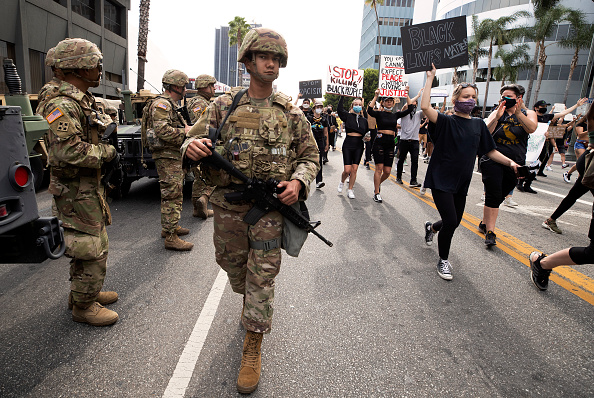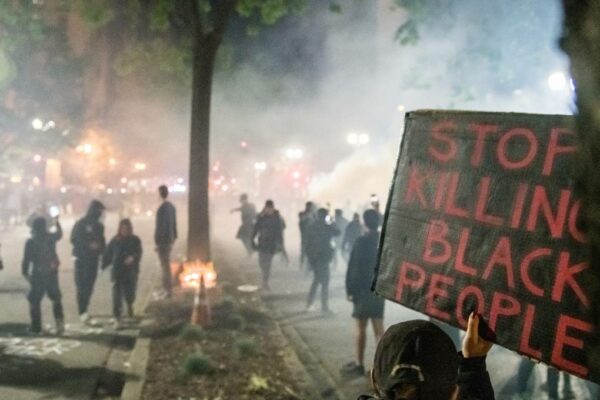
Archive for June, 2020
National Guard Troops at Protests: What Does It Mean? What Can They Do?
Thursday, June 4th, 2020

A deployment of 50 National Guard troops played a well-publicized role on the streets of Vallejo on Tuesday and Wednesday nights, patrolling to keep government property and critical infrastructure safe amid some reports of illegal activity and violence that took place alongside protests over the Minneapolis police killing of George Floyd.
“Our officers are exhausted, but they’re resilient, and they’re committed to safeguarding our city. But we needed the additional resources to safeguard many of the businesses that were severely damaged on Monday,” said Vallejo Police Chief Shawny Williams at a press conference on Wednesday.
Even in extraordinary times, seeing an organized deployment of National Guard troops in the streets adds an element of surprise. In fact, the California National Guard has not been called out to quell a protest since 1992, when then-Gov. Pete Wilson deployed thousands of the guard in the racially charged aftermath of the Rodney King riots. The historical parallels are clear.
As of Wednesday evening, 3,899 National Guard personnel were activated to back up local law enforcement dealing with racial justice protests across the state, according to Lt. Col. Jonathan Shiroma, a spokesman with the California National Guard. Most were deployed in and around Los Angeles at the request of Mayor Eric Garcetti.
On Wednesday morning, the Solano County Sheriff’s Office sent guard troops back to standby duty, but called them up again later in the day. Vacaville had 50 troops on hand Tuesday, but they were also released. And 50 soldiers had deployed to San Leandro but were turned around by local law enforcement and told they were not needed, according to Shiroma.
Nationally, more than 17,000 guard troops in 23 states and the District of Columbia have been deployed in cities that have seen some violence following the killing of George Floyd on May 25, according to numerous media reports.
Neither Police Nor Neutral Peacekeepers
The National Guard has had a meaningful presence in the Bay Area and across the state in recent weeks for a completely different reason: to help staff food banks and augment hospital staff amid the COVID-19 pandemic.
The California National Guard has been activated by the governor to deal with other crises as well, ranging from wildfires to earthquakes.
“You’ll find that what separates us from the active forces is that our soldiers and airmen are part of your community. So whatever city we’re deployed to right now, we have men and women who live in that specific city,” Shiroma said.
That said, the National Guard are a branch of the U.S. military. When you join up, you are sent to basic training. You are armed with a service weapon. And some day, you may find yourself facing down a crowd of protesters.
So what is the National Guard empowered to do?
“There are totally different rules concerning using force that are in place for Guard soldiers when they are assigned to a mission like we’re seeing right now,” Shiroma said. “We do not have the authority to arrest citizens, but we’re able to detain someone until we can turn over the individual to the proper law enforcement agency.”
National Guard troops aren’t police, but they aren’t neutral peacekeepers either. They typically come under a “coordinated command structure” that serves the goals of the police or sheriff’s department that requested their presence, according to Brian Ferguson, deputy director of communications for California’s Office of Emergency Services.
That said, “in most cases, the Guard is not going to do front-line law enforcement. They’ll be doing logistical support, moving things around in trucks,” or securing a site while police work elsewhere, said Ferguson.
California has 4,500 enlisted National Guard troops, and the coronavirus pandemic has prompted a jump in applicants.
“It’s something we see when a national crisis happens,” said Shiroma.
Tags: Black Lives Matter, George Floyd, Julia Scott, KQED, National Guard, Racial Justice, Vallejo
Posted in Feature | Comments Off on National Guard Troops at Protests: What Does It Mean? What Can They Do?
Four Bay Area Cities Have Used Tear Gas. Here’s How It Makes COVID-19 Worse
Tuesday, June 2nd, 2020

As demonstrations against police brutality roil the country for a second week, protesters across the Bay Area continue to put their bodies on the line, weighing the risk of injury or exposure to the coronavirus against continuing to tolerate the status quo.
The risk of personal harm now extends to inhaling tear gas, which four Bay Area cities have deployed multiple times since Friday — in Oakland, Walnut Creek, San Jose and Santa Rosa.
It’s a combustible — and controversial — choice in light of the known respiratory complications of COVID-19, according to two experts who spoke with KQED.
“If somebody has COVID-19 and they get tear gassed, they’re going to be coughing more. They’re going to be spitting more. They’re going to be shouting more in pain … so that’s one risk,” said Peter Chin-Hong, a professor and specialist in infectious diseases at the UCSF School of Medicine.
The other risk is that tear gas could degrade the lungs and make a protester more susceptible to coronavirus infection down the line, he added.
It’s almost like you’re getting an asthma attack,” he said.
Chin-Hong published a strongly worded petition this week on behalf of fellow infectious disease, public health and medical professionals. It makes a point of affirming the ongoing demonstrations against systemic racism and police oppression, while offering pointed public health guidance to law enforcement and government officials trying to handle protests.
Among the pieces of advice: Stop using tear gas immediately. Also, stop detaining protesters in enclosed spaces like police vans and jail cells, which are likely to increase COVID-19 transmission.
Civil rights advocates are likewise concerned about the spread of the coronavirus in jails, following hundreds of arrests in the Bay Area since demonstrations began on Friday. In Alameda County, for example, some protesters were sent to Santa Rita Jail in Dublin.
“We have massive concerns for people getting exposed inside the jail who are protesting and getting booked inside,” said Carey Lamprecht, a legal worker with the National Lawyers Guild.
Protesters who have been tear gassed may not be able to continue wearing their masks, increasing their risk of exposure to COVID-19, said Art Reingold, professor and head of epidemiology and biostatistics at UC Berkeley’s School of Public Health.
“It’s obviously a thorny conundrum. If you want to be out there and protest and stay safe — these are hard things to balance. If you’re going to be there, be sure of wearing a mask,” he said.
But don’t continue to wear a tear-gassed, wet mask, Reingold said, since tear gas is already harmful at that point and the mask may no longer serve as protection.
“In general we think that when masks become wet, that they are not as good at preventing the spread of virus,” he said.
Oakland City Council President Rebecca Kaplan has been sorting through the complaints her office has received about the conduct of police officers who tear gassed young protesters on Friday, Saturday and Monday nights. She strongly opposes the use of tear gas under the circumstances.
“They say the point is to try to protect the community from things getting out of hand. But tear gas does the opposite,” Kaplan said. “When demonstrators are behaving peacefully, deploying a harsh munition like this can really hurt people, especially in a pandemic. It also pushes the crowd to places of greater danger.”
Kaplan said she has asked for “clarity” about how police decided tear gas was justified, given Oakland’s policy limiting its use.
KQED asked several cities to explain their use of tear gas or share their policy. An Oakland Police Department spokesperson said they would look into KQED’s questions. A San Jose Police Department representative said the agency had no details to share “at this time.” The San Francisco Police Department said its officers did not use tear gas over the weekend or on Monday night.
Tags: Black Lives Matter, COVID-19, Julia Scott, KQED, Oakland, Tear Gas
Posted in Feature, Uncategorized | No Comments »
© 2024 Julia Scott.